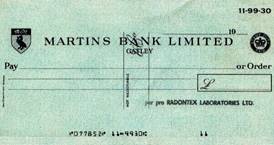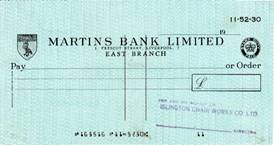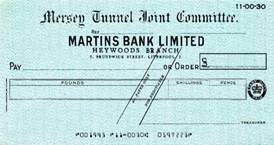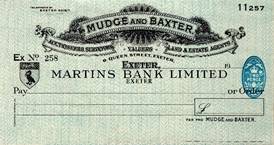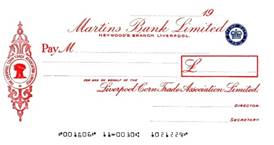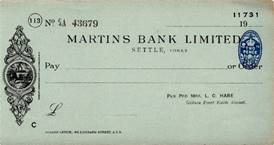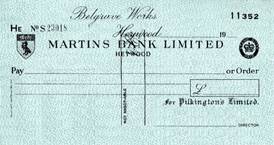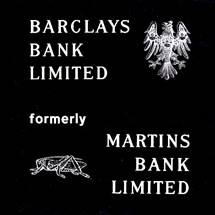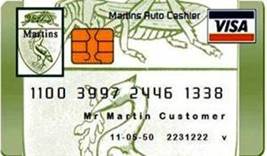|
|

![]()
|
MARTINS BANK AT YOUR SERVICE –
CORPORATE BANKING |
![]()
|
|
WHY NOT ALSO
VISIT |
|||||||||||||||||||||||||||||||||||||||||||||||||||||||||||||||||||||||||||||||||||||||||||||||||||||||||||||||||||||||||||||||||||||||||||||||||||||||||||||||||||||||||||||||||||||
|
|
||||||||||||||||||||||||||||||||||||||||||||||||||||||||||||||||||||||||||||||||||||||||||||||||||||||||||||||||||||||||||||||||||||||||||||||||||||||||||||||||||||||||||||||||||||||
|
Up, up and away!
It’s only money…
(Each lucky winner will have received a share of £50, which in 1964 was the equivalent of winning about £950 in 2017)
Sailing by…
Cap in hand.
Menage a trois? ,
{Special factors
affecting Martins
92. Some of the
reasons for merging discussed in the foregoing sections apply with especial
force to Martins, particularly the potential increase in the size of
facilities required by large companies and the need for wider overseas
connections. Equally significant from
the point of view of Martins are the problems created by incomplete national
coverage at a time of growth in the geographic range of industrial and
commercial customers and of greater mobility of personal customers, and the
high capital cost of attempting to achieve national coverage by the
establishment of new branches.
Furthermore, in recent years there has been an increasing tendency for
the banks to compete by moving into related fields and by developing
ancillary services – export houses, factoring, leasing, credit cards,
etc.. Martins by reason of its size,
is at a competitive disadvantage in this respect.}
Barclays’ submission to the
Monopolies Commission
Report For Submission To The Monopolies Commission re The Automation Activities Of Barclays Bank Limited and The Savings Which Will Result From the Merger Of Barclays, Lloyds And Martins Banks This report is intended to present a factual survey
of the Automation activities upon which Barclays Bank Limited are engaged.
The second part of the paper seeks to give an indication of the gains which
will follow the proposed merger. Equipment The
Bank's total complement of computers, installed or on order, is as follows:- IBM 1 x
360/65 (purchased) 4
x 360/50 (3 purchased, 1 temporarily rented) 10 x 360/30 (all purchased) 3
x 1401 (2 purchased, 1 rented) Burroughs 1
x B8500 (purchased) ICT 2 x
Emidec 1100 (purchased) Punched Card equipment is being built up; so, too,
are the number of Branch Terminals, Input Machines and Amount Encoding
Machines. In all fields the objective
has been to order sufficient hardware to permit completion of the Bank's
current plans Computer
Centres There are seven
of these either in being or in course of preparation as follows: -
Staff
Projects in hand or already completed Barclays Bank Limited first became interested in the
possibilities of automating certain of its activities as long as 10 years ago
and opened its first branch book-keeping Computer Centre in 1961. The Bank decided, as a matter of policy,
not to commit itself to a large scale programme of automation until suitable
third generation equipment became available. It was only approximately three
years ago that the decision was taken to move into automation across a very broad
front. Some of the projects referred to in this report are already completed
and the remainder will be completed by early 1971. The equipment which is
shown has been bought or ordered with a view to enabling this to be done and
where the choice has been between additional equipment and a manual process
(e. g. teleprocessing as opposed to Van Collection of Input) the decision has
invariably been to go for the additional equipment and thereby avoid
increasing our manpower requirements. The projects to which we have referred above are as
follows: - § Branch
Book-keeping § Standing Orders
and Direct Debiting § Clearing
Operations § Registrar's
Department § Chief Foreign
Branch § Executor and
Trustee Business § Staff Salaries
and Statistics § Barclaycard § Customer
Services, e. g Payroll, Stock Analysis,
etc. § Magnetic Tape
Exchange between Banks and their Customers. § Branch
Securities § Management
Information § Management
Science Techniques. It will be appreciated that many of these projects
are of immense magnitude and have involved extensive preparatory work and
planning. Distribution
of Activities and Computers Inevitably there are from time to time transfers of
work and/or machines between Centres, but the following describes the present
position adjusted to incorporate changes now imminent:-
The Willesden Centre, which is to receive the
Burroughs computer, should be commissioned later this year. Initially it will undertake only branch
book-keeping, retaining spare capacity for later developments. Current plans
are to move the book-keeping now performed at the No.1 and Lombard Street
Centres and concentrate this at Tottenham Court Road and Willesden by 1971.
Lombard Street Centre will be closed. No. 1 Centre will be used for computer
processing of the Foreign work for the three banks. Constraints In its planning the Bank has had to act within two
main constraints, namely: -
Because of these the Bank has had to continue with
its plans and the execution thereof during the period since its proposal for
a merger with Lloyds Bank Limited and Martins Bank Limited was referred to
the Monopolies Commission. Expected Gains from the Proposed Merger
between Barclays, Lloyds and Martins Banks This part of the paper gives an indication of the
total gains, both short-term and long-term, which may be expected in: -
Both Barclays and Lloyds have particularly heavy commitments
in respect of branch automation programmes, which they need to meet in full
before decimalisation. This date,
February 1971, therefore becomes a convenient demarcation line between
“short-term” and “long-term”. The short-term gains can be more readily
assessed than the long-term ones, though there is no doubt that both will be
considerable. SHORT-TERM SAVINGS Systems and Development Staff Barclays and Lloyds each have a Systems/Programming
strength of 150 skilled staff, whilst Martins have 34. These numbers are
growing and, of necessity, there must be some duplication of effort, so that
a saving of 125 in the short-term maybe regarded as a conservative estimate.
It is emphasised that these are highly qualified people whose skills are
becoming yet more pronounced as computer development progresses Their short
supply is a national problem which is likely to grow rather than lessen in
the years ahead. Management Science Management Science in banking is an exciting new
prospect to which Barclays are increasingly devoting resources. Their team will grow to some 30 highly
skilled analysts, comparable in strength to that of Bankers Trust Company of
New York who are leaders in this field. The Barclays’ team will handle the
work for the three banks following the merger and there will be no need for
their duties to be duplicated by Lloyds and Martins. A team of at least
equivalent numbers to that of Barclays can thus be saved in entirety. These
are the elite of the operational research area; M.Sc’s and B.Sc’s of high
calibre who are nationally in great demand. Organisation and Methods Barclays, Lloyds and Martins all have resources allocated
to this field of operations and Barclays, in particular, are in the process
of building up their O. & M. section from 50 to some 120 staff so that a
clerical work improvement programme (Work Study) may be introduced throughout
the entire bank. Lloyds and Martins will benefit from the manual of
predetermined time data which is being established, and in addition it is
considered that one O. & M. Team
instead of three will produce short-term savings of at least 25 staff. Martins Branch Automation Martins are about to plan the automation of their
branch network, which would involve them in central computer equipment
costing £1,500,000.
Their 1 million accounts can be accommodated either on Barclays’ Burroughs
computer, or on Lloyds Birmingham Computer Centre, at an estimated cost of
not more than £500,000, principally for disk storage. There would be related
savings of space and of some 60 skilled operating staff. Clearing Departments The total staffs of the three banks’ Clearing
Departments number more than 2,000. The major savings will follow the
long-term amalgamation, but short-term it is considered that at least 50
staff, principally concerned with distribution tasks in the City of London,
can be saved. Share Registration. Lloyds’ Registrar’s Department is already fully
automated, using an IBM 360/40 at Worthing.
Barclays’ Registrar’s work is in the process of being automated and
could be comfortably accommodated on the Lloyds’ computer. Apart from
releasing the Barclays’ computer for other tasks, it is estimated that some
100 Barclays’ staff would be saved, over and above those that would have been
surplus following their own automation programme. Credit Cards Lloyds intention to enter the credit card field
would entail the employment of a minimum staff of 385. Barclaycard have now developed an extremely
able staff and have, too, acquired considerable expertise. Their Management
consider that the Lloyds work could be absorbed into their existing
organisation at the cost of 100 staff, thus saving 285 people. Computer and
ancillary equipment savings can be conservatively assessed at £200, 000, whilst Lloyds would also benefit from not
having to undertake the considerable development work inherent in such an
operation. Foreign Work Barclays are well advanced with the automation of
their Chief Foreign Branch. This is an involved and complex task, and Lloyds
and Martins can take advantage of all the preparatory work which has been
completed. In addition, by re-arranging their computers Barclays will
undertake the whole of the Foreign automation work for the three banks, thus
freeing Lloyds’ and Martins’ computers of an equivalent task. The No. 1 Computer Centre (Drummond Street) will be
vacated pre-decimalisation and into there will go the IBM 360/50 earmarked
for Barclays’ Chief Foreign work, together with the “Barclaycard” 360/50 from
Northampton. Back-to-back these two
computers will handle the total foreign work and provide stand-by. Into
Northampton for the Barclays branch clearing will go the IBM 360/30 which is
at present spare in the Greater London Centre and to this will be linked the
duplex 1419’s. The Barclaycard updating run, at present processed on the
Northampton 360/50, will be run overnight on one of the “Foreign” 360/50’s. Trustee Work Lloyds Bank have already made much progress in the
systems/programming studies which precede the automation of their Trustee Department.
Barclays can benefit from the acquisition of this work. Customer Services This is an area into which all the banks will
increasingly make inroads, undertaking a wide variety of services such as
payroll, stock control, discounted cash flow and cheque reconciliation.
Barclays have already developed computer programs and can make these
available to Lloyds and Martins. Branch Terminals The intention of the three banks is to link all
their branches to main computer centres by means of terminal equipment and G.
P. O. telephone lines. The terminal equipment costs from £3,000 to £4,000, depending on type, whilst the running
expenses vary inversely to the capital expended. For every branch closed, or not
opened, following the merger, there
would therefore be an immediate capital saving of up to £4,000, together with
lower running costs, whilst the demand for Post Office telephone lines would
be reduced at a time when the G. P. O.
is faced with a major programme of line networks for the banks, to be
completed by decimalisation. (See also BRANCH ACCOUNTING) The short-term savings may be summarised
in the following chart:
Annual
Savings
Capital
Savings
Long-Term Savings Capital savings on branch terminal equipment, with
the corresponding lessening of demand on the G. P. O. for telephone lines, will continue for as
long as does the branch rationalisation programme. Every branch closed, or not opened, in the future will mean a reduction of up
to £4, 000 on capital outgoings, plus
related savings in running expenses. There will,
too, be continued saving of Specialist staff and in the long-term it
is considered that another 50 systems/programmers will be spared as a result
of combining the research and development work. At that stage, therefore,
the requirements for highly qualified data processing staff will have
been reduced by some 290, quite apart
from the savings to be achieved in the short-term from Registrar’s
Department, Credit Cards or Clearing Department, and quite separate from any long-term
savings which will follow the amalgamation of the Clearing department or the
Computer Centres. An amalgamation of the Clearing Departments of the
respective banks can profitably be undertaken. Two courses will be open; to
merge the entire clearing operations into one London Centre (as against the
present arrangement of three centres in London and one in Northampton), or to
process the total branch clearing in Barclays’ branch clearing centre in
Northampton and amalgamate the general clearing into one London centre. At
the worst, this will mean two clearing
centres instead of four and will produce capital equipment savings in the
region of £1
million, since an amalgamation would require 4 fewer reader/sorter systems.
Not only will this in itself lead to fewer skilled operating staff, but
further substantial staff savings will follow the removal of the need for
inter-bank settlement in respect of the considerable quantity of items which
will automatically change from the category of general clearing to branch
clearing To quantify more exactly the total benefits which will accrue in
this area will call for a detailed study by a combined inter-bank team. Further principal gains from the merger will be
realised when the various branch systems have been rationalised and are fully
compatible. A joint study team can commence immediately to plan this
work, but completion of the task is
unlikely to be effected before decimalisation. Subsequently, however, with
full compatibility of branch systems,
it will be possible to merge the computer centres of the three banks
and to complete such an undertaking by about 1974. The merit in having purpose-built centres is
becoming clear, for in themselves they bring economy of operation. Barclays
and Lloyds, individually, would certainly have to face this in the seventies.
Together, and with Martins, they could
reap the advantages of a combined operation. Whether the three banks, when
merged, will wish to go for just two super-centres, one near London and one
in the North, or for three or four centres sited at various strategic
geographical points, has yet to be decided. There is something to be said for
each course. Either way, to a greater or lesser degree, there will stem from
such an amalgamation the following benefits:-
At present it is not possible to quantify these
long-term savings This will require a detailed investigation of some
magnitude. What is very evident is that if we job-back to a point in time
five, or seven years ago, we can
visualise the time, effort and capital
which could have been saved in the field of automation had we acted in unison
as one bank rather than as three separate entities. There is every reason to
believe now that comparable gains will be achieved in the future as the
result of concerted policy and action. Management
Services Department, 16th
April, 1968 Special Thanks to
Barclays Group Archives What
might have been?
|
||||||||||||||||||||||||||||||||||||||||||||||||||||||||||||||||||||||||||||||||||||||||||||||||||||||||||||||||||||||||||||||||||||||||||||||||||||||||||||||||||||||||||||||||||||||









